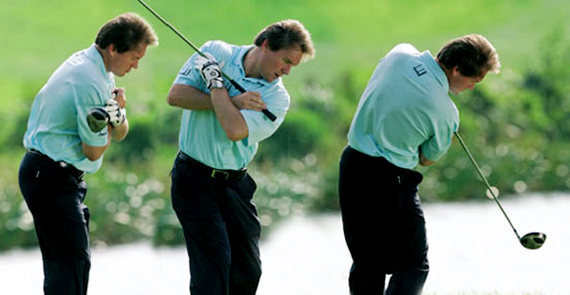Tuition
Logical Golf
by Robert BakerLesson 8 – Use these images to visualise the dynamic inside track The process of learning a good swing is accelerated 100-fold when you have in mind a good image of what you are trying to achieve.
So, while it’s important that you recognise the killer ‘Over-The-Top’move on the previous page, I want you now to erase it from your memory bank and focus instead on this downswing sequence, taken from a slightly oblique angle to emphasise the naturally correct inside attack on the ball.
Like the discus thrower spinning his body to accelerate the arms and the throw itself, the good golfer uses the rotation of his body core to swing the arms – speed that is multiplied through the wrist action to plant the maximum clubhead speed on the ball.
Unwinding from the ground up is the key to harnessing this energy, and when you do that (as Robert illustrated earlier) the arms fall naturally on to the shallow delivery plane that sees the club apprach the ball on this inside path.
That’s the simple geometry of a naturally correct golf swing.
The club approaches the ball from the inside, and travels down the target line for a couple of inches before swinging inside once again to the finish. Only when you swing from the inside can you hope to reap the benefit of a good rotary motion of the body ‘core’ and plant the clubface squarely on the ball at maximum speed.
As soon as you get outside the line, you forfeit the ability to use the muscles in your stomach to good effect. When you learn to unwind from the ground up, you also retain the wrist angle that is necessary to ‘throw’ the clubhead at the ball for solid impact.
A great way to develop this is to take a heavy training club and just swing backwards and forwards with a continuous swinging motion. As your body responds naturally to the task of swinging that extra weight, so that extra momentum will get you swinging on the inside, both back and through. [octo_single_image image=”113481″ img_size=”full” alignment=”center”]
Get left shoulder behind the ball as you turn into a braced right knee
[octo_single_image image=”113482″ img_size=”full” alignment=”center”]
Unwinding from the ground up drops the arms, hands and the club on to this shallow delivery plane. Wrists remain ‘loaded’, ready to snap the final burst of acceleration on the ball
[octo_single_image image=”113483″ img_size=”full” alignment=”center”]
Utilising rotary speed from the body allows the club to go down the line for accuracy. More levers. more speed – better results
One more thing.
All good players trust in the ‘throwing’ of the clubhead – the release that allows the toe to catch up and ultimately pass the heel. If your divots are across the ball to the left (typical of a slicer), visualise the toe beating the heel (or the club being closed) before you strike the ball. A good wrist action and this good visual will get you back on track.Series Introduction & Masterpost
